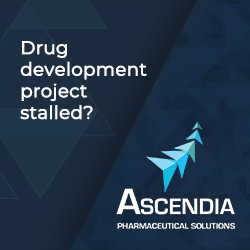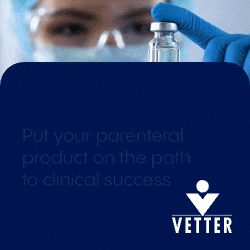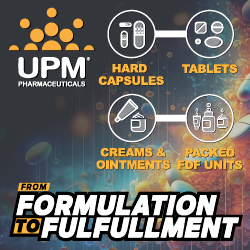Issue:March/April 2025
TREND SCOUTING - Anticipating the Future of Pharma
INTRODUCTION
Innovation in today’s world moves at a fast pace. Various industries are experiencing unprecedented growth, and pharma and biotech are no exception. The global pharmaceutical contract development and manufacturing organization (CDMO) market is expected to grow from $161 billion US to $322 billion US from 2023 to 2033.1 Total reported R&D spend has increased from $139 billion in 2022 to $145 billion in 2023, an increase of 4.5%.2 This immense growth across the industry indicates a need for CDMOs to proactively invest in the tools, technologies and process optimization which will shape pharmaceutical manufacturing in the coming years.
With the constant evolution of the biopharmaceutical industry, companies need to maintain their competitive edge to succeed in the market. Outsourcing partners in particular need to make sure their service portfolios address shifting customer needs and remain at the forefront of the industry. A large part of this is adapting a forward-thinking mindset to consistently innovate and predict potential solutions in time before customers want to address new challenges.
By implementing a strategic, considerate, and proactive approach to trend forecasting, pharmaceutical service providers can effectively weigh the benefits and challenges of potential trends, invest in those most aligned with customer needs, and avoid the allocation of time and resources in trends that will not provide meaningful return on investment (ROI). Let’s explore the development of reliable trend scouting processes through tried-and-true methods.
INFORMATION-DRIVEN PREDICTIONS
Service providers can sustain a holistic view of emerging trends by scouting ahead. This is an important approach for surveying, analyzing, and implementing the latest in components, technologies, and methodology to meet future and evolving customer needs. As, for example, new devices or substance classes, to name a few, emerge and gain popularity, the needs of the market will change. This makes trend scouting a critical skill to acquire the foresight to proactively innovate and maintain relevance and resilience in today’s market.
Globally operating CDMOs have large customer bases of biopharma companies that have nuanced requirements and products. Scouting and tracking industry trends allows outsourcing partners to collect valuable information from drug owners that can inform decision-making to implement the required infrastructure, devices, substances and more.
That said, trend scouting can be a cumbersome process. The life science industry has innately special requirements for the implementation of new methods due to regulations and required risk management. With patient safety the top priority for manufacturing partners, trends don’t emerge and permeate as quickly as they do in other industries. Substantial time and resources are required to implement the most relevant trends. Comprehensive practices help prevent a service partner from missing any crucial topic and allow the focus to remain on getting ahead of lengthy implementation timelines.
UNDERSTANDING THE VALUE OF TREND SCOUTING
Trend scouting highlights the importance of evaluating comprehensive market needs, rather than single customer needs, to make careful use of available resources, and is a key element of a holistic risk management system. Today, how trends evolve can somewhat be unpredictable and may change frequently. For example, as biopharma companies plan to introduce drug products to market in novel devices like wearable on-body-injectors, they might find a lack of adequate reimbursement for drug delivery systems. While the tried-and-true system of drug delivery has established proper reimbursement practices, new system products are more likely to be reimbursed if they offer a significant improvement in patient treatment outcomes.
Emerging topics may rise and fall, sometimes disappearing for a while only to re-emerge later with fresh enthusiasm. CDMOs understand the importance of dedicating significant time and resources to monitoring trends to create solutions that address future customer needs yet avoid straining resources prematurely. However, because it can take years for fill and finish partners to address new ideas in the industry, it’s essential to look beyond the short term and focus on long-term trends when evaluating trend risk management.
By conducting a comprehensive trend tracking, the companies can benefit from becoming early adopters of emerging trends by integrating new technologies and methods into their supply chain long before they become the industry standard. Implementing new and trending practices to address future customer needs can lead to marketability in a competitive industry. Staying on trend can entice new customers to partner with you. The ability to strategically adopt elements of a new trend allows a biopharma service provider to become a leading voice in the market and cultivate trust in their expertise from customers. However, when a company is slow to adapt to a new trend or misses a potential trend in their scouting that ends up panning out, they can fall behind in the market and lose out on customer relationships.
 HOW TO IDENTIFY POTENTIAL PROMISING TRENDS
HOW TO IDENTIFY POTENTIAL PROMISING TRENDS
CDMOs are well advised to keep an eye on the biopharma industry. Monitoring for potential trends can be crucial as the first step in the trend tracking process to enhance operations and offer valuable capabilities to customers.
Before investing in a technology or method in response to a potential trend, it may be beneficial to conduct thorough assessment of its potential value and risks. Adoption of any new trend or technology needs to support existing quality standards and current Good Manufacturing Practices (cGMP). The key to successful trend scouting can be optimizing the flow of information from every channel and outlet. The trend scouting team can absorb information from sessions and discussions at conferences and trade shows, as well as from academic journals, new datasets and studies, evaluations of new technologies, and conversations with customers.
By systematically comparing trends against one another and in the context of their area of focus, they can create a truly comprehensive trend radar to predict the future of the market and derive the required action from the most relevant trends. This tool, which is used across different departments and overseen by management to identify, monitor and evaluate potential trends, involves grouping potential trends into distinct categories. Experts in different departments look at various areas in the industry to monitor trends on several topics and make thoughtful recommendations for a path forward.
The potential trends are then ranked by experts based on their current relevance and predicted applicability for the future. Often, experts try to find topics that might become the new industry standard. For example, large volume autoinjectors have become a competing trend for on-body wearable injectors as the call for solutions to meet the rising customer need for self-administered injectables at a higher dosage increases.
Throughout the trend evaluation process, it may be helpful to maintain a balance of qualitative and quantitative research. We employ various methods to obtain and confirm information about emerging trends. For example, desk research with market reports from respected sources and new regulation and authority feedback provide valuable quantitative research. On the other hand, customer and partner interviews as well as conferences and trade shows offer important qualitative findings. Together, the various sources of qualitative and quantitative research contribute to trend tracking efforts.
The trend tracking process should be ongoing and consistent to account for any shifts and changes in the market. Outsourcing partners can then use these insights to inform customers of the latest and most promising trends to help them make crucial implementation decisions regarding their devices and substances.
THE IMPACT OF SUCCESSFUL TREND FORECASTING
Trend scouting enables manufacturing partners to adjust practices and processes to relevant trends in a timely manner. By implementing new methods to adapt to the right trends, CDMOs can maintain their competitive edge against other pharmaceutical service providers in the long run. In our experience, trend forecasting throughout the company’s history has proven valuable in contributing to long-term success.
When prefilled syringes first entered the market in the mid-20th century, it marked a significant advancement in global injectable technology. Vetter recognized early on that patient-friendliness would be the trend of the future, which is why the company focused on prefilled syringes as early as the 1970s. Vetter was well prepared when prefilled syringes became the new standard. The company led the emergence and growth of this trend by introducing the original idea of a prefilled syringe, which became a core element in drug production during that decade. In 1984, Vetter sought to get ahead of the industry trend and introduced the first dual-chamber syringe. Today, advanced prefilled syringes remain a market standard.
Vetter is continuing to lead the injectable market with its early investment in a new trend: ready-to-use vials and cartridges. The company is tracking the trend closely and dedicating a new clean room for the prefilled syringe-equivalent of vials. By installing an increasing amount of flexible equipment, CDMOs can process primary packaging types in various shapes, sizes and yearly volumes consistent with how the industry evolves. Remaining flexible can be important as trend scouting can sometimes lack precision in its predictions.
Trend scouting and tracking is necessary to monitor trends constantly and with proper care. Using the right resources and employing appropriate time management may be beneficial in trend forecasting to help companies know which trends are the most critical to implement. As CDMOs’ ability to first meet future customer needs becomes more competitive, the capacity to perform extensive trend scouting will be instrumental in anticipating evolving market needs. A holistic approach is needed to provide the best possible trend forecasting that spans the entire industry, engaging in interdepartmental conversations and monitoring to create a comprehensive picture of the market.
The future of the biopharmaceutical industry is bright, as the global market continues to grow and evolve. By leveraging all available sources of information, understanding the value of trend scouting, and developing a comprehensive trend radar system, CDMOs can be prepared for industry shifts far enough in advance to adapt accordingly.
REFERENCES
- Mikulic, M. (2024) “CDMO market size worldwide forecast 2023-2033.” Statista.
- Dondarski, K, et al. (2024) “Unleash AI’s potential. Measuring the return from pharmaceutical innovation – 14th edition.” Deloitte. https://www2.deloitte.com/content/dam/Deloitte/us/Documents/life-sciences-health-care/us-rd-roi-14th-edition.pdf.

Gregor Deutschle serves as the Director Product and Service Management at Vetter since 2021. In this role, he leads a team responsible for matching Vetter’s product and service offering with the demand of the biopharmaceutical market and evolving the portfolio according to the latest industry trends. Prior to joining the independent CDMO, he worked in several roles over the past 16 years, most of them in the biopharma industry. He started his career by earning a degree in mechanical engineering from RWTH Aachen University in 2008.
Total Page Views: 2611















